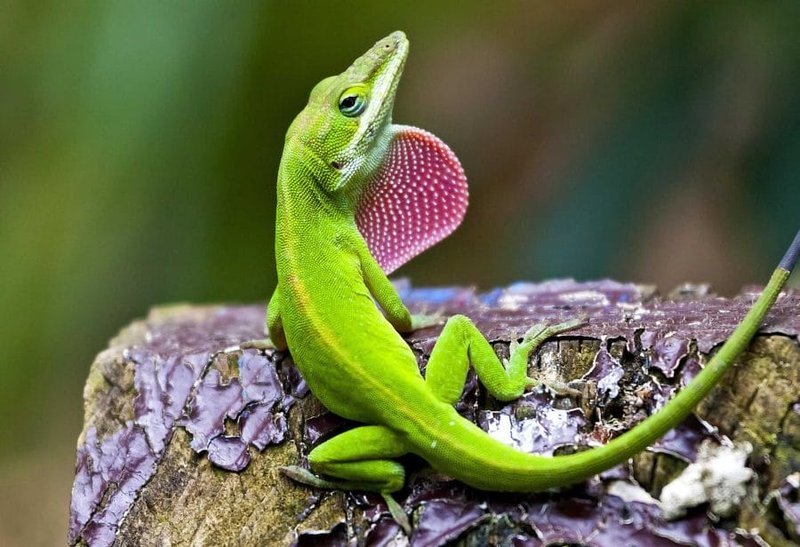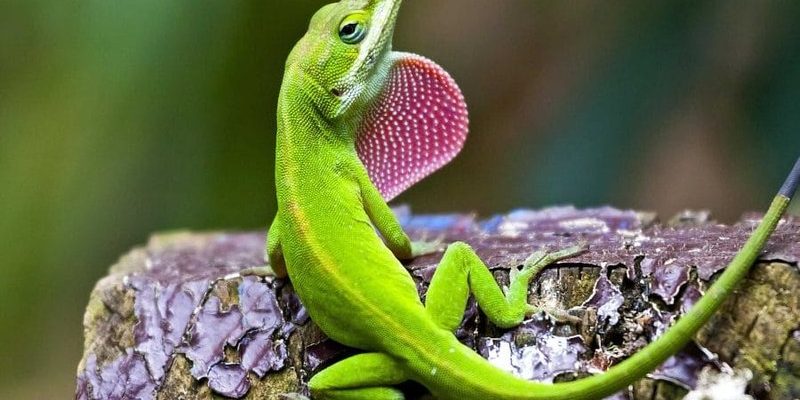
In this article, we’ll explore ten fun and surprising facts about anole lizards. From their remarkable ability to change color to their unique mating rituals, you’ll find that these little guys have some fascinating stories to tell. So grab a cup of coffee, settle in, and let’s dive into the world of anoles!
Anoles Have Color-Changing Powers
You might think of chameleons when it comes to color-changing abilities, but anole lizards have their own impressive flair. These lizards can shift colors based on their mood, temperature, and even social interactions. For instance, when a male anole feels threatened or is trying to attract a mate, it might turn a brighter, more vivid hue.
Here’s the thing: while they don’t change colors in the same dramatic ways as chameleons, anoles have a talent for blending into their surroundings. A green anole can turn brown when it needs to hide from predators, making it a master of camouflage. This ability not only helps them avoid danger but also assists in regulating their body temperature by absorbing more sunlight or reflecting it away.
What’s fascinating is that these color changes aren’t just for show. They play a critical role in communication among anoles. For instance, during mating season, males display bright colors to attract females, showing off their health and vitality.
They’re Masters of Climbing
Anole lizards are born climbers! Their specialized toe pads allow them to grip surfaces like a pro. You may have seen one climbing smoothly up a tree or hopping from branch to branch. Thanks to tiny hair-like structures on their toes, called setae, they can cling to various surfaces with impressive ease. This adaptation helps them escape predators and hunt for food.
Let me explain how this works: the setae create a strong adhesive force that allows them to climb straight up walls or hang upside down. It’s like having built-in sticky pads on their feet! This skill also makes them excellent at navigating their forest homes, where they can find food and shelter.
But climbing isn’t just for fun. It allows anoles to reach their primary sources of food—small insects and other invertebrates. So, the next time you see one scaling a wall, remember, it’s not just playing acrobat; it’s on a mission!
They Communicate with Body Language
Anole lizards don’t just rely on their colors; they also have a unique way of expressing themselves through body language. You might notice them bobbing their heads or extending their colorful throat pouches, called dewlaps, to send messages to other anoles.
During mating season, males will puff up their dewlaps and perform push-ups to grab a female’s attention. This display can be both mesmerizing and a bit competitive. The more vigorous the display, the more likely the male is to attract a mate. Think of it like a dance-off in the animal kingdom!
Furthermore, when an anole feels threatened, it might adopt a defensive stance and puff up its body to look larger and more intimidating. It’s a clever way to send a warning to potential predators while also showing off its stunning colors.
They Have Unique Mating Rituals
Speaking of attracting mates, anole lizards have some pretty interesting courtship behaviors. Male anoles are known for their elaborate displays to woo females. In addition to using their vibrant dewlaps and head bobbing, they often engage in a dance-like movement, showcasing both agility and grace.
Here’s the thing: once a female is interested, she’ll often respond by bobbing her head in return, showing she’s receptive. After mating, the female will lay eggs in a safe, hidden spot, and then leave them to develop on their own. Unlike some species that nurture their young, anoles don’t provide any parental care after laying eggs.
This might seem a bit harsh, but it allows the female to focus on survival and finding more food. Nature has its ways, right?
Anoles Come in Many Varieties
With over 400 different species, the anole lizard family is incredibly diverse. Species can be found in various colors, sizes, and habitats. The most common, the green anole, is often seen in gardens and parks across the southern United States. Meanwhile, the brown anole is prevalent in urban areas and even considered an invasive species in some regions.
You might be wondering why this variety matters. Different anole species have adapted to thrive in specific environments, which means they’ve developed unique traits to help them survive. For example, some species are better suited for climbing trees, while others prefer to stay on the ground.
Each species plays an important role in their ecosystem, controlling insect populations and serving as food for larger predators. So, next time you see an anole, remember: there’s a whole world of lizards out there, each with its unique story!
The Life Cycle of an Anole
Let’s talk about how anoles grow up. The life cycle of an anole starts with the female laying eggs in a safe spot, often buried in soil or hidden under leaves. These eggs take about 6-8 weeks to hatch, depending on environmental conditions. Once hatched, tiny anoles are independent right from the start, ready to fend for themselves.
As they grow, these lizards will go through several molts, shedding their skin as they increase in size. This process is crucial because it allows them to grow and helps remove parasites that might be clinging to them. Watching an anole shed its skin can be quite a sight, as the once-flaky skin peels off to reveal a brighter and healthier version beneath.
You might be surprised to learn that anoles can live for several years in the wild, longer in captivity with proper care. They are resilient little creatures, adapting to their environments while dealing with the challenges of survival.
Anoles Have Unique Defense Mechanisms
When it comes to survival, anoles have some clever tricks up their sleeves. In addition to their ability to change color and blend into their surroundings, they can drop their tails to escape predators. This process, called autotomy, allows them to flee while the predator is momentarily distracted by the wiggling tail. It’s a bit like a magician’s trick!
Here’s the thing: while losing a tail might sound scary, it’s a useful survival tactic. Anoles can regenerate their tails over time, though the new one is often different in color and texture. This regeneration process can take several weeks to months, but it allows the lizard to get back on its feet—literally!
However, dropping their tail does come with a cost. They lose some fat reserves and may be more vulnerable to predators until the tail regrows. Nevertheless, it’s a small price to pay for survival in the wild.
They Play Key Roles in the Ecosystem
Lastly, let’s talk about the ecological importance of anole lizards. As insectivores, they help control the population of pests like mosquitoes, flies, and other small insects. This makes them valuable allies in maintaining a balanced ecosystem.
Furthermore, they serve as prey for a variety of larger animals, including birds, snakes, and even larger reptiles. By being part of this food web, anoles contribute to the health of their habitats. It’s a cycle of life that underscores the interconnectedness of nature.
Anoles are also indicators of environmental health. If you notice fewer of these lizards in an area, it might signal issues like habitat loss or pollution. Keeping an eye on their population can help conservationists take measures to protect their environments.
In conclusion, the world of anole lizards is as vibrant and colorful as their scales. From their remarkable color-changing abilities to their crucial roles in the ecosystem, these little lizards are true survivors. Next time you see one, take a moment to appreciate its fascinating life and the wonders of nature surrounding us.

